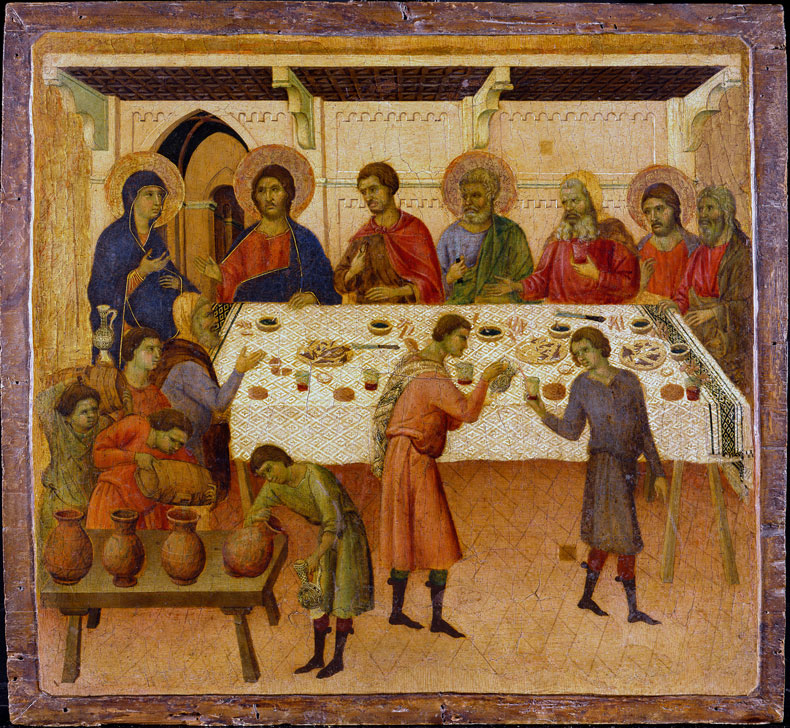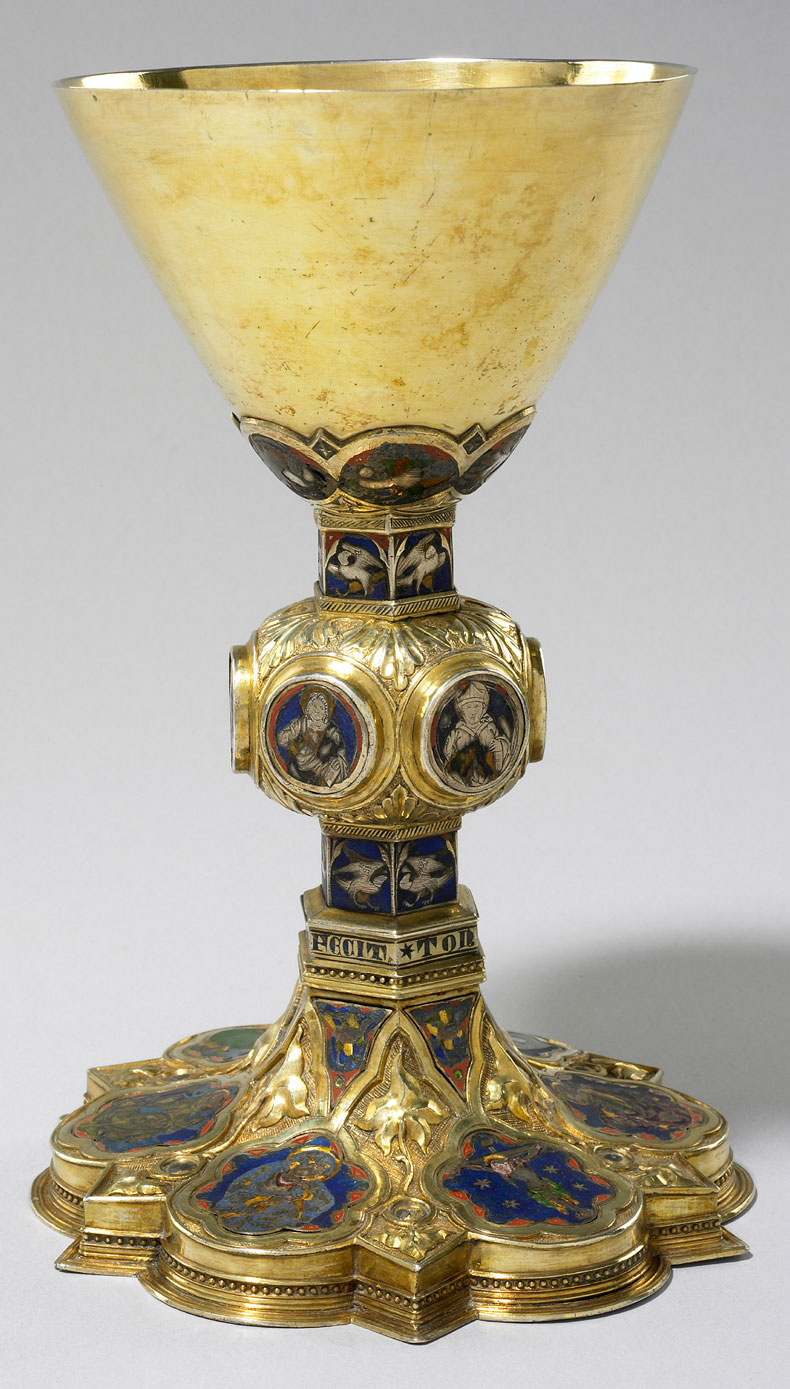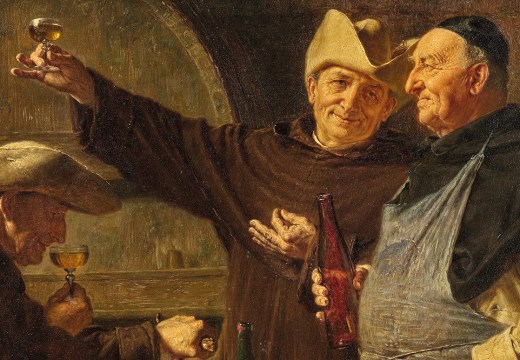From the May 2025 issue of Apollo. Preview and subscribe here.
The works in the National Gallery’s exhibition ‘Siena: The Rise of Painting, 1300–1350’ (until 22 June) shimmer with the emerald and ruby robes of saints, the ivory skin and cat eyes of Madonnas and the exuberant geometry of early Renaissance architecture. Several crucifixions feature: in one, Jesus’s wounds spurt crimson blood; in another, he hangs limply with blood trickling down his pierced feet; in yet another, he reappears as a vision, his blood transformed into wings. The colour homology between the red of blood and wine is well established in Judaeo-Christian traditions – Genesis 49:11 mentions ‘the blood of grapes’. Wine comes alive when Christ dies and Eucharist wine is never white.
At the exhibition’s centre stand a series of works from Duccio di Buoninsegna’s masterpiece Maestà, the free-standing, double-sided altarpiece created for Siena cathedral, with its golden array of the Virgin Mary, angels, saints, patrons and soldiers on the frontispiece. Executed in around 1308, it was the largest art commission of its time and documented in the State Archives of Siena. Duccio was venerated as the city’s most important artist when the altarpiece was installed with great fanfare in 1311. The back of the altarpiece – presumably reserved for the eyes of clergy – contains panels depicting some 50 scenes from Christ’s life and Passion, a patchwork of representational experiments in architecture, figural proportions and colour relationships.
On one particular panel displayed here, ‘The Wedding at Cana’, a table is carefully set to reveal clues into the drinking culture of the Old Master’s own life and times. According to the biblical story, Jesus and his mother attend a wedding in Judaea when the host runs out of wine. ‘They have no wine,’ Mary says. Jesus replies, ‘Woman, what does this have to do with me? My hour has not yet come.’ The scene captures this presumed argument between son and bossy mother, yet they are off-centre in the composition, with the bride and groom nowhere to be seen. Instead, we are presented with a dining scene, figures in various poses, conversations and angles. The focal point is the table with its white and blue jacquard tablecloth presenting an array of prandial objects – knives, bread, plates of meat and bones – at different points of consumption. The details are minute and multiple; the quotidian is revered.
The wine in the glasses is red. In the Bible, Mary ‘said to the servants, “Do whatever he tells you”’; here, the eye is drawn to the busy servants taking orders. At Jesus’s instruction to fill six large stone jars ‘to the brim’, water is going in and wine is coming out, via small casks and water jugs.
In biblical times, wines were thick and concentrated, infused with spices and fruits such as saffron, cinnamon, mandrakes and pomegranates. In the territory of the ancient kingdom of Judah, archaeologists have found evidence of jars with fermented traces labelled as ‘smoked wine’, ‘very dark wine’ and ‘wine made from black raisins’, implying the vinification of grapes dried on vines or in the sun to make thick wine. Today, these winemaking styles persist in Amarone or Vin Santo. In Duccio’s panel, the earthenware jugs are trecento Tuscan, as wine in his time was not aged but drawn straight from the cask. Thus, whatever Duccio’s models are drinking would be young, slightly coarse by modern standards and probably occasionally diluted with water.

The Wedding at Cana (1308–11), Duccio. Museo dell’Opera della Metropolitana, Siena. Photo: © Foto Studio Lensini Siena
Food and wine would feature in the Last Supper (panel three), where even though there is the narrative drama of Jesus offering bread to Judas (and John seems to be sleeping on the table), the white tablecloth is present with the familiar glasses of red wine, knives, a platter of lamb and the flourish of a contemporary Tuscan maiolica jar.
Wine has been an integral part of the Sienese landscape for at least 800 years, thanks to auspicious soil and geoclimatic conditions. The same civic archives that document the contract and payment details for Duccio’s commission also record his debts and fines for drunken behaviour and misdemeanours. Another connection to wine is revealed by a land deed from 1304, where he is named as the owner of a vineyard in the Castagneto area (site of today’s Super Tuscan estates in the Livorno). Prosperous citizens would own vineyards or orchards for personal supply.
Duccio’s contemporary tablescaping also appears in panel seven, ‘Appearance While the Apostles are at Table’, where Jesus’s followers are arranged as though they are extensions of objects on the table, which is set with plates of fish, bread loaves, knives and, naturally, the same red wine.
In Duccio’s time, wine was ubiquitous in Tuscany, since it was safer to drink than water. Urban records suggest nearly a litre per person per day was typical. Siena had 19 winemakers in the first decade of the 14th century. Tuscan wines of the period included the progenitor wines from Montalcino and Montepulciano, which we know today as venerable Brunello and Vino Nobile, dessert wines and medicinal wines (like today’s Vin Santo), all from early Sangiovese varietals in the surrounding hills.
The scenes in the panels are religious and intended to command spiritual devotion. However, the minuscule details of the table scenes also honour the ordinary, which deserves its own veneration. After all, as the master of the wedding feast at Cana says, ‘Everyone serves the good wine first, and when people have drunk freely, then the poor wine. But you have kept the good wine until now.’

Chalice (c. 1320) designed by Tondino di Guerrino and Andrea Riguardi. British Museum, London. Photo: © The Trustees of the British Museum
From the May 2025 issue of Apollo. Preview and subscribe here.














![Masterpiece [Re]discovery 2022. Photo: Ben Fisher Photography, courtesy of Masterpiece London](http://www.apollo-magazine.com/wp-content/uploads/2022/07/MPL2022_4263.jpg)
Suzanne Valadon’s shifting gaze